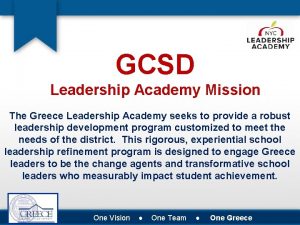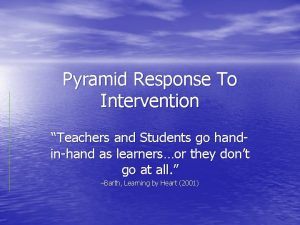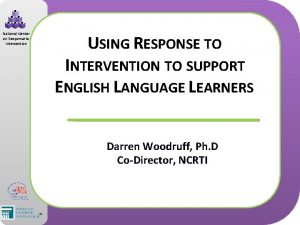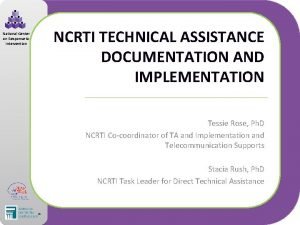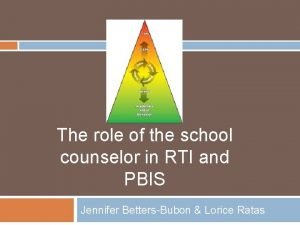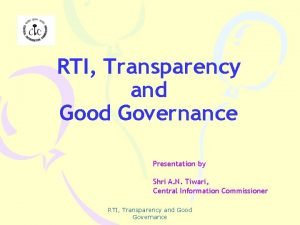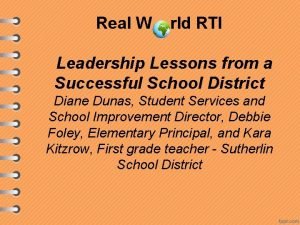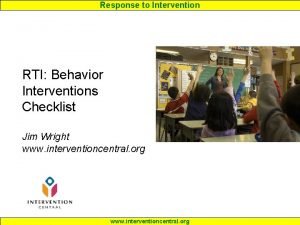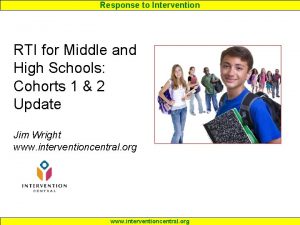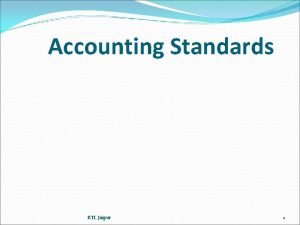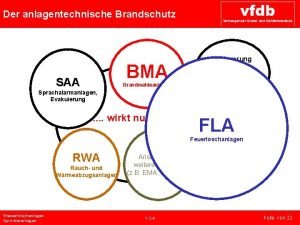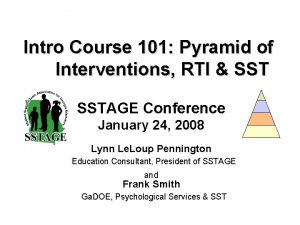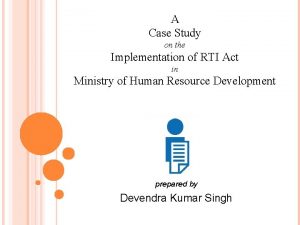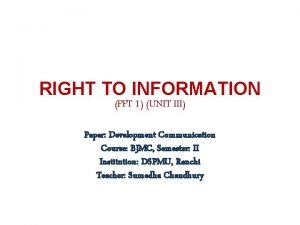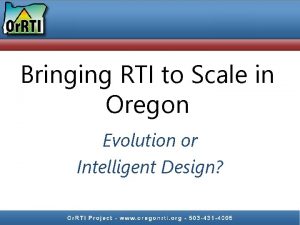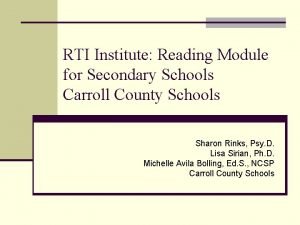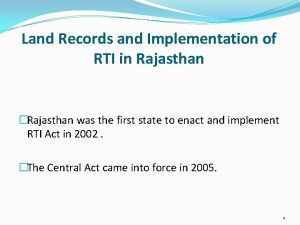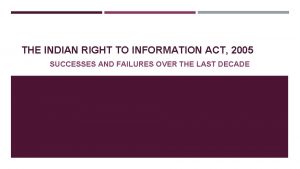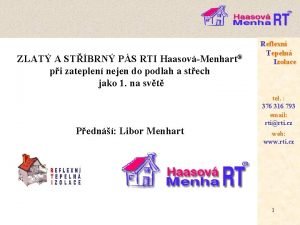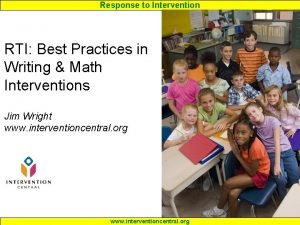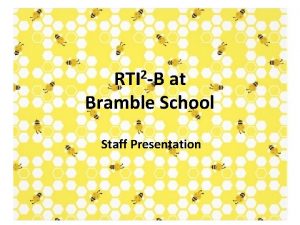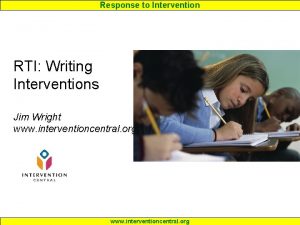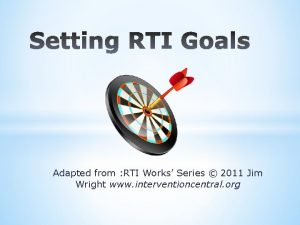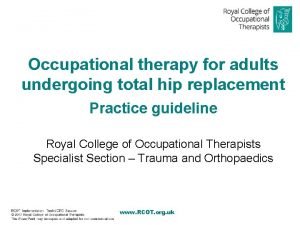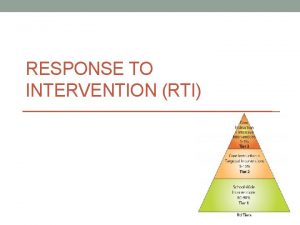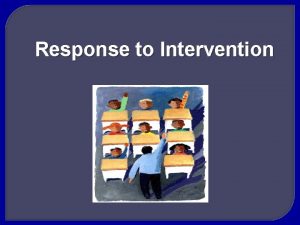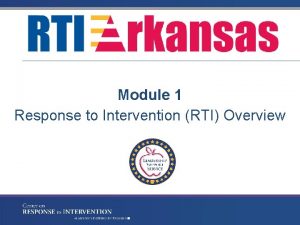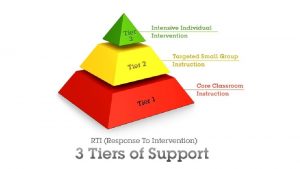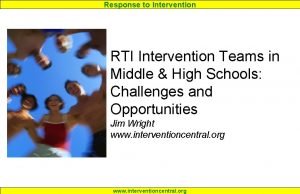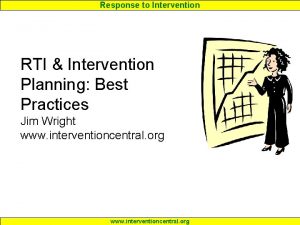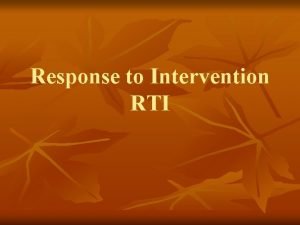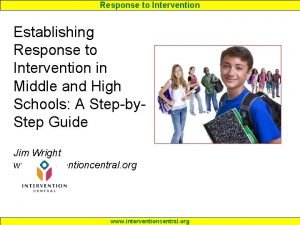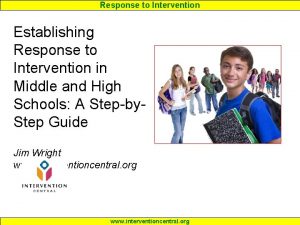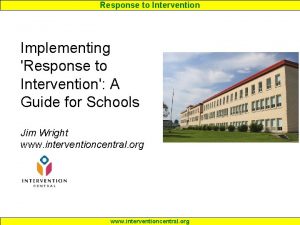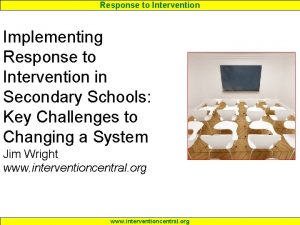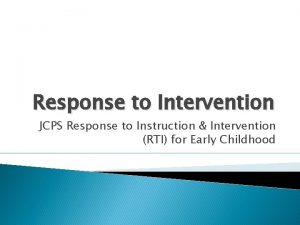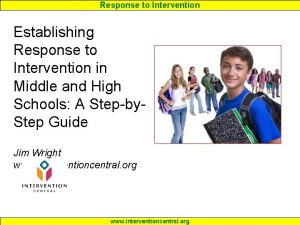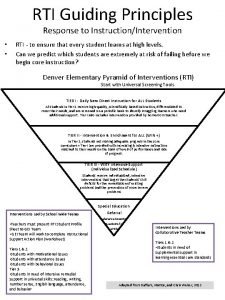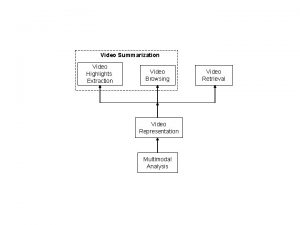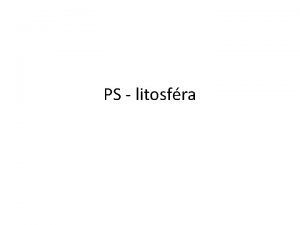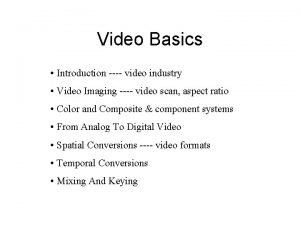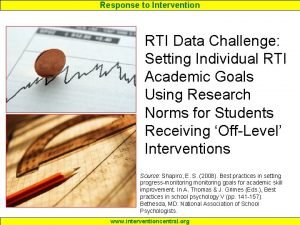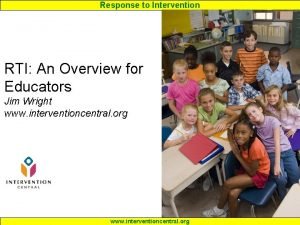Response to Intervention RTI What is RTI video














![Negative Comments about Teacher Performance “I need help with something and she’ll [the teacher] Negative Comments about Teacher Performance “I need help with something and she’ll [the teacher]](https://slidetodoc.com/presentation_image_h2/ab5fe64fce1526579870bc2fcfe67652/image-15.jpg)

![Self-Reflection about their Behavior “I go into my own like, world when they [teachers] Self-Reflection about their Behavior “I go into my own like, world when they [teachers]](https://slidetodoc.com/presentation_image_h2/ab5fe64fce1526579870bc2fcfe67652/image-17.jpg)






















- Slides: 39

Response to Intervention (RTI) What is RTI (video)? How are the stakeholders being affected by the implementation of the IDEA law (legal cases)? How are schools across the country implementing response to intervention? What does an RTI problem solving meeting look like (video)?

What is RTI? (Colorado Department of Education) http: //www. cde. state. co. us/Rt. I/Tools. R esources. Rt. I. htm

RTI Summary of the Tiers

Tier 1 (CDE, 2008) This tier creates the basis for understanding. It is the most important level. The teacher gauges the level of understanding by differentiating instruction, incorporating ongoing universal screening, and progress monitoring.

Tier 2 is for students who have been identified as at-risk, and/or are underachieving.

Tier 3 This tier is a more intensive support, and interventions are provided for students who exhibit more chronic deficits.

Stakeholder: Parent (Byrd, 2011) A student named Juan, in kindergarten, struggled to recognize letters and numbers. Claudia, Juan’s mom, met with the teacher several times and was given activities that she could do at home. By the end of the year, Juan still lagged behind his peers.

Parent Experience with RTI … After Juan entered 1 st grade, Claudia got a phone call from the Response to Intervention team. They wanted to meet with her. Claudia discovered that her son needed Tier 2 interventions and progress monitoring. She received another call and was told that Tier 2 was not successful and he needed Tier 3 interventions.

Claudia’s Confusion … Claudia did not understand what all of this meant, so she got online and researched RTI, and how she could help her son. After she did her research, she found information that differed from what was being done for her son. She felt frustrated and wondered if the school knew what they were doing

Websites for Parent Help http: //www. rti 4 success. org/ http: //www. rtinetwork. org/

Stakeholder: Students (Conca, 2010) Mike is eleven and in fourth grade. He is reading at a first grade level. He finished the year at a second grade level. His confidence and motivation declined. Once he was able to track his own progress, his confidence and motivation improved.

Mike’s Background Mike has ADD He has bitten a teacher. He began having headaches. A neurologist discovered he was missing a portion of his right cerebellum.

Girls in a Juvenile Delinquent Facility (Ritzman 2010) These girls were asked how they would teach if they were the teacher. Suggestions for Teacher Improvement. Negative Comments about Teacher Performance. Positive Comments about Teacher Performance. Self Reflection

Suggestions for Teacher Improvement on an RTI reading program “Why don’t you do the kid who knows how to read really well, and the kid who kinda knows how to read, and the kid who doesn’t know how to read. together as a group? ” (p. 49)
![Negative Comments about Teacher Performance I need help with something and shell the teacher Negative Comments about Teacher Performance “I need help with something and she’ll [the teacher]](https://slidetodoc.com/presentation_image_h2/ab5fe64fce1526579870bc2fcfe67652/image-15.jpg)
Negative Comments about Teacher Performance “I need help with something and she’ll [the teacher] sit there and she’ll explain it but she’s just explaining it in the way that she understands and doesn’t explain it to me. ” (p. 49)

Positive Comments about Teacher Performance “When I was going to a smaller school, my grades were getting better because I was getting more one-onone help in the classroom. ” (p. 49)
![SelfReflection about their Behavior I go into my own like world when they teachers Self-Reflection about their Behavior “I go into my own like, world when they [teachers]](https://slidetodoc.com/presentation_image_h2/ab5fe64fce1526579870bc2fcfe67652/image-17.jpg)
Self-Reflection about their Behavior “I go into my own like, world when they [teachers] are talking. I don’t focus, I just scribble on a piece of paper. ” “Using materials and stuff, was a lot easier to learn. ” (p. 49)

Help for Students For managing behavior (student p. 84) http: //www. jimwrightonline. com/pdfdocs /tbrcmanual. pdf For managing academics http: //www. interventioncentral. org/index. php/math/98 -computation-selfmonitoring-aitnd-performancefeedback

How should we teach students who are at-risk?

Teaching ideas … These students need more one-on one time or small group attention. Scaffold difficult concepts. Differentiate instruction by using visual, auditory and visual techniques.

Stakeholder: School - legal case Ethical Concerns (Burns, 2008) The parent wanted Special Ed testing for her son, but the school did not think their son was ready. According to this court case, Johnson vs. Upland, the courts made a decision in favor of the school because the school documented that the student was making progress in the RTI process.

What does this mean for schools (Mellard, 2009)? For legal reasons, keep data on your students. Document changes in interventions.

Screening and Progress monitoring confusion … Tracking reading improvements vary from state to state. Some schools use dibels (90%) while other schools use district or state assessments (11%); Others used published reading assessments (36%).

How are western regional states implementing RTI (Mellard, 2009)?

Frequency of assessment When using Dibels, 23% assessed triennially. state assessments were progress monitored annually (11%). 14% of schools measured progress quarterly or biannually. (p. 4)

Cut-off points for at-risk students varied from school to school Some schools measured the cut off for being at-risk by using correct words per minute while others used reading fluency. Other schools targeted the lowest 25%, 16% or 15% of their school population. Some schools didn’t use a cut-off at all – just a convergence of data from a variety of assessments (p. 4).

How should schools measure at risk-students?

What is the answer? Use national norms to determine whether a student is considered to be at-risk. Screen for students who could be at risk in the spring, winter, and fall. Use that information to guide decisions concerning interventions (p. 5 -6).

Follow No Child Left Behind guidelines for interventions Rigorous data analysis measurements that provide valid data across evaluators interventions that are peer reviewed and contain the five components of reading (U. S. Department of Education).

Stakeholder: School (Deno, 2010) One midwest school, Forrest Elementary, analyzed their test scores in 2004. They have 290 students and serve pre-k through fifth grade. 79% are on free and reduced lunch, 50% come from a minority background and 20% make up the ELL population, and finally, 13% make up the special education department.

Forrest Elementary School RTI Results In 2006, after two years of implementing the RTI system, Tier 1 has increased from 30% to 40%, Tier 2 has remained the same and a much smaller percentage of students have moved to Tier 3 – from 44% to 31%

How do they implement the RTI system? Their tiers are flexible and they use a four point system to determine a change in intervention. According to this rule, if the four data points are all below the goal line after 6 to 8 weeks of data collection, a teaching change is made. If the data points are all above the goal line, the goal line is raised and if the data points are both above and below the goal line, the intervention is continued.

Stakeholder: Teacher Realize that since response to intervention is still new, evidence of researched based intervention are sometimes difficult to find. Peer reviewed interventions are still scarce for students who are progressing through the tiers, and for students who are ELL or in the secondary grades.

Suggestions for Research-Based Interventions For reading interventions http: //www. fcrr. org/ For math interventions http: //www. lindamoodbell. com/on-cloudnine. aspx http: //www. interventioncentral. org/index. php? option=com_content&view=article &id=195

Legal Case (Walker 2010) A court case from Elpaso, Texas described a student who should have been tested for special education rather than go through the RTI process. The court explained that this student failed the Texas Assessment of Knowledge and Skills, for three years in a row, and continued to display significant academic difficulties.

The Court’s Judgment … The courts found that 13 months had passed between the parents request for an evaluation and the offer of an evaluation. In this case the courts decided against the response to intervention process because the delay in assessing him for special education constituted a violation of the child find law.

When should intervention and assessment take place? In this case there were no definite timelines. The school district needed to initiate intervention strategies within a 10 to 18 week period of time, or 50 to 90 days prior to making a referral for special education evaluation. Assessments for special education should begin 45 to 60 days after the parent requests the evaluation.

Problem solving video for Academic Need http: //www. cde. state. co. us/media/rti/tr aining 01/rtivideo 01. html

Bibliography Byrd, S. E. (2011). Educating and involving parents in the response to intervention process: The Schools Important Role. Teaching Exceptional Children. Conca, L. M. Legere, E. J. (2010). Response to intervention by a child with a severe reading disability: A case study. Teaching Exceptional Children. 43, 32 -39 Deno, S. L. , Garmen, C. , Lembke, E. S. , Stecker, P. M. (2010). One elementary school’s implementation of response to intervention (rti). Reading and Writing Quarterly. 26, 361 -373. doi: 10. 1080/10573569. 2010. 500266. The Colorado Department of Education. (2008). Response to intervention A practioners guide to implementation. Retrieved from http: //www. cde. state. co. us/rti/Learn. About. Rt. I. htm
 Simplifying response to intervention
Simplifying response to intervention Response to intervention pyramid
Response to intervention pyramid National center for response to intervention
National center for response to intervention National center on response to intervention
National center on response to intervention Digital media primer
Digital media primer Video yandex b****
Video yandex b**** Video.search.yahoo.com
Video.search.yahoo.com Tw.search.yahoo.com
Tw.search.yahoo.com A subsequent
A subsequent Natural and forced response
Natural and forced response Natural response circuit
Natural response circuit Rti school counseling
Rti school counseling Rti and good governance
Rti and good governance Rti meaning real estate
Rti meaning real estate Rti behavior checklist
Rti behavior checklist Rti sceduler
Rti sceduler List of accounting standards in india
List of accounting standards in india Pegasus opera 3 review
Pegasus opera 3 review Nassalarmventilstation
Nassalarmventilstation Https://serp.doe.louisiana.gov
Https://serp.doe.louisiana.gov Upper rti
Upper rti Rti zeromq
Rti zeromq Rti interventions examples
Rti interventions examples Rti case study
Rti case study Rti act ppt
Rti act ppt Rti templates
Rti templates Rti oregon
Rti oregon Rti graph
Rti graph Rti portal rajasthan
Rti portal rajasthan Rti act 2005 introduction
Rti act 2005 introduction Rti izolace
Rti izolace Rti interventions list
Rti interventions list Rti 2
Rti 2 Jim wright intervention central
Jim wright intervention central Jim wright rti
Jim wright rti Rti zeromq
Rti zeromq Hmrc rti gtax
Hmrc rti gtax Micro system social work
Micro system social work Government intervention in exchange rates
Government intervention in exchange rates Occupational therapy hip replacement interventions
Occupational therapy hip replacement interventions
